I find the seed raising discussions on this Forum of Gene, Rick and others absolutely fascinating.
I have no experience in the use of fluorescent lights ,baggies, etc as living in a somewhat 'soft' climate i just sow seed and place it outside as soon as i receive it,regardless of the time of the year.
If i consider the pots are getting too wet i place a poly sheet over the pots .It's not a fail safe method - Sure :) in an individual pot i lose a few to rot but not all however ,as a number do come up.
Following are current pics with the date of sowing --unfortunately i haven't kept records of when germination occured ,(might need to look at doing so from now on).
Some of the seed trays .
Muscari macrocarpum -- x Tasmania sown in late Nov 2012-- My thumb shows the size of the small pots that I generally use.
Clintonia udensis-- x AGC of BC sown early Feb 2010.
Lilium wigginsii --x Gene sown mid spring ,beginning of Nov 2011 .
Pulsatilla turczaninovii --x Rick sown early winter ,middle of June 2012.
Cheers Dave.

Comments
Richard T. Rodich
Re: Seed starting chronicles 2013
Sun, 04/21/2013 - 8:39pmI love every aspect of growing. Even when things aren't successful, lessons learned are so valuable!
Mark, I didn't find any germination references specific to Alium sacculiferum, and I had so much of the seed from you that I planted an equal amount for two different germinating regimes:
1) Sow directly at room temperature.
2) Sow at 40F for 2.5 months, then room temperature.
Both were planted at the same time, and now it's time to bring trial #2 out of the fridge....
Aquilegia canadensis Little Lanterns is a dwarf strain. It grows about a foot tall, and is dwarf in all respects. I am a bit curious about the dark leaves of the seedlings. The seed was collected from my own plant in 2012 that came from a commercial nursery in 2011. I have never noticed that the mother plant had darkish leaves, and even though I was careful to collect seeds from only flowers that bloomed when no other aquilegia were blooming, I don't have any that have dark leaves anyway.
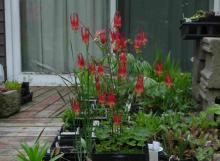
Gene Mirro (not verified)
Re: Seed starting chronicles 2013
Mon, 04/22/2013 - 8:59amMimulus lewisi, sown 2/27/13, germinated at 60F, grown under lights:
[attachthumb = 1]
Mark McDonough
Re: Seed starting chronicles 2013
Wed, 04/24/2013 - 7:56pmThanks Rick, 'Little Lanterns' is exceedingly cute. I've seen the all yellow variant named 'Corbett', didn't impress me seeing small plant in nursery centers, but now when I look via Google images, it can make a nice clump.
Tony Willis (not verified)
Re: Seed starting chronicles 2013
Mon, 04/29/2013 - 3:54amI have now started sowing my fritillaria and lilies in pure cat litter (Sophisticat Pink). I use clay pots which are plunged in a sand bed. Just a top dressing of grit on the pots.I feed well until they die down and then repot them firstly to look at the results and secondly to space them out. This is easy as clean white bulbs are easily seen amongst the clay granules.
Fritillaria unibracteata just germinating from a January 2012 sowing
Fritillaria crassifolia from an August 2010 sowing germinated spring 2011
Richard T. Rodich
Re: Seed starting chronicles 2013
Wed, 05/01/2013 - 8:54amNomocharis aperta - planted 25Mar2013 at 60-65F. Emerged in 31 days.
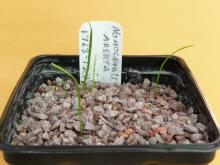
Allium carinatum ssp. pulchellum - planted 7Feb2013 outside temps. Emerged 29Apr2013.
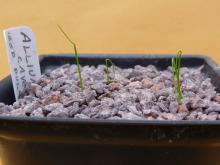
Allium tricoccum - planted 19Mar2011 (dried seed),outside temps. Emerged 23April2013.
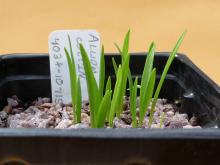
Other seeds up:
Allium narcissiflorum - planted 7Feb2013 outside temps. Emerged after two 70F days on 30Apr2013.
Allium ovalifolium - planted 3Feb2012 outside temps. Emerged after three 70F days on 1May2013.
Fritillaria meleagris alba - planted 3Feb2012 outside temps. Emerged after three 70F days on 1May2013, as expected.
Mertensia ciliata (Thanks Lori!) - planted 3Feb2012 outside temps. Emerged after three 70F days on 1May2013.
Oxytropis nana - planted 3Feb2012 outside temps, not scarified. One seed germinated last season. More emerged after three 70F days on 1May2013.
Richard T. Rodich
Re: Seed starting chronicles 2013
Thu, 05/02/2013 - 7:24pmHedysarum boreale ssp. boreale, I think. As I was planting various species, I neglected to mark this one right away, so its identity is through a process of elimination. Initially, I thought I might have it mixed up with Moltkia petraea, but I grew that seed last year and had taken and posted a photo for it in Seed Chronicles 2012. (Everyone's additions here are very helpful!) So it's not Moltkia.
So what do you think? The seed would have come from Lori (Thanks!).
Emerged in 29 days at 60-65F.
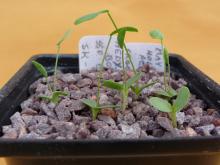
A curious happening with this batch: all of the cotyledons grew in a somewhat "abnormal" fashion. Most grew to "one side" as the seedling on the right. But none emerged perfectly shaped, as one might expect. Is this normal, or could it be due to some climatic factor?
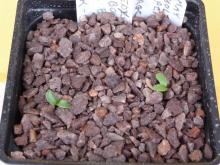
Trond Hoy
Re: Seed starting chronicles 2013
Fri, 05/03/2013 - 10:26amRick, I think the cotyledons of Fabaceae species often are warped or asymmetric. Some don't even surface.
Gene Mirro (not verified)
Re: Seed starting chronicles 2013
Sun, 05/05/2013 - 1:44pmMimulus lewisi, sown 2/27/13, grown under fluorescents at roughly 60F:
[attachthumb = 1]
These are perennial in the NW USA for 2-5 years if the soil is kept moist and cool. They are native to wet places in the mountains above 5000 feet.
cohan (not verified)
Re: Seed starting chronicles 2013
Wed, 05/08/2013 - 4:09pmThose Mimulus have really come along, Gene! I'm thinking about getting something in this genus for damp lower edges (below grade) of some rock gardens, but I don't think I got any seed yet, unless there is some in my package from Kristl..lol
Trond Hoy
Re: Seed starting chronicles 2013
Fri, 05/17/2013 - 12:05amWell done, Gene!
Toole (not verified)
Re: Seed starting chronicles 2013
Sun, 05/19/2013 - 1:49amSome good success shown there folks.
Here's a few different genera sown at different depths last month ,germinating after being placed outside unprotected.
Lilium oxypetalum var insigne --seed surface sown.
Myosotis capitata ---surface sown.
Crocus biflorus ssp isauricus sown just under the surface --i scraped away a little of the mix to see what was happening....
Ornithagalium sigmoideum sown deep.
Arisaema griffithii sown deep after chilling for 5 weeks. Thumb is shown to give an idea of the seed pots.
I'll move them under cover at the end of the month to keep them going over winter.
Cheers Dave.
Toole (not verified)
Re: Seed starting chronicles 2013
Sun, 05/19/2013 - 2:31amI continue to be seduced by seed . ;D
I understand Saxifraga longifolia is not that difficult to germinate so as an experiment last month i surface sowed half of a 'swap' on pumice and the other half on peat/grit and placed them outside .
Other than the different mixes both pots were given identical ,(as much as i could control),conditions ,each placed in a plastic bag which was tied --however after a week because of the amount of the condensation i left the bags open with the plastic ,stiff ,well above the sides of the pot to try to continue giving them a settled atmosphere.
So far the results have been interesting .
The pumice pot is showing advanced germination compared to other one.
Followed by a couple of macro shots showing the seed in various stages of germinating on and between the rock .
Cheers Dave.
Trond Hoy
Re: Seed starting chronicles 2013
Wed, 05/22/2013 - 11:25amDave, have you tested other seeds on pumice?
Several seedpots have germinated the last week and now I hope for higher temperatures!
Trientalis borealis germinated after 2 winters outside. Seed from Kristl Walek. I am not quite sure of the difference between this and the European T. europaea though!
Trond Hoy
Re: Seed starting chronicles 2013
Thu, 05/23/2013 - 1:34pmForgot to say that the big plant in the previous replay is a weed! But surely you did understand that!
Here are something new that has germinated: Mistletoe (Viscum album). Got berries from a forumist on SRGC this spring and squeezed the seed onto several rowan and linden stems. A lot of them have germinated but climbing snails have found them irresistible! Hope some survive.
Toole (not verified)
Re: Seed starting chronicles 2013
Fri, 05/24/2013 - 12:56amHoy
At the same time i sowed the Saxifraga above , as a continuation of the experiment i also sowed half of a portion of Ramonda and also in another pot,Physoplexis, under the same conditions on pumice and the other half sown on peat/grit with all pots placed outside in plastic bags ....... --none of those pots have sown any activity yet.
Cheers Dave.
Richard T. Rodich
Re: Seed starting chronicles 2013
Fri, 05/24/2013 - 7:56pmWow, mistletoe!
I think you win the prize for most unusual angiosperm seedling, Trond. 8)
Trond Hoy
Re: Seed starting chronicles 2013
Sat, 05/25/2013 - 1:32pmThanks Dave, please keep me (us) updated on your pumice experiment!
Rick, I hope I get some to reach more than the seedling stage!
Richard T. Rodich
Re: Seed starting chronicles 2013
Sat, 05/25/2013 - 6:58pmAllium carinatum ssp. pulchellum planted 7 Feb inside for 2 weeks, then placed outside where they emerged on 30 April.
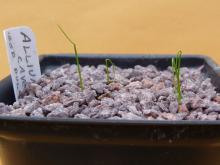
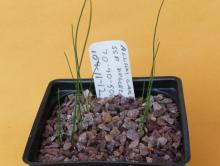
30 April 2013 22 May 13
Draba polytricha planted in Late May 2012, one seed emerged in 10 days and eventually withered. These emerged 6 May 2013.
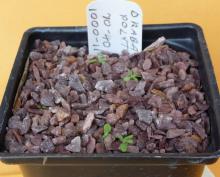
Iris lutescens planted 30 Jan 2012, emerged 17 May 2013.
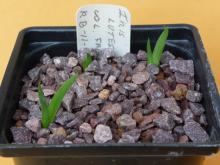
Lilium nanum ex Sikkim and Lilium nanum var. flavum both emerged on the same day after 3 weeks at 60-65F under lights, then 2 weeks outside in varying temps of 40-80F and lots of rain.
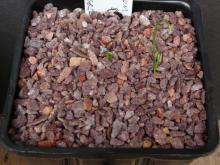
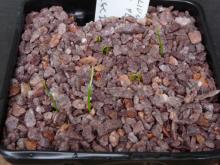
Penstemon nitidus planted fall 2011 emerged 14 May 2013. I planted two lots from the same batch: one with seeds that were planted as received, the other I rubbed between my fingers to remove the superficial covering and reveal the true seed before planting. So far, only the rubbed seed has come up.
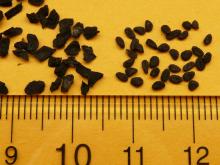
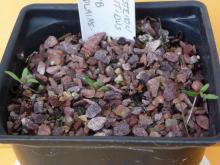
P. cobaea seed,
natural and rubbed. P. nitidus
Penstemon speciosus wild collected in Nevada. Planted 3 Feb 2012, emerged 13 May 2013. A few more had germinated, but only one left...
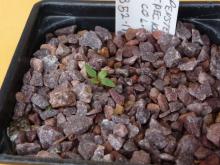
Veronica fruticans (thanks Trond!) from Myking, Norway. Planted 3 Feb 2012, emerged 17 May 2013. Our 2012 spring started a month early so they only had a month of cold conditioning in 2012. Apparently that wasn't enough.
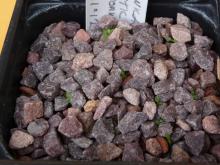
Richard T. Rodich
Re: Seed starting chronicles 2013
Sat, 05/25/2013 - 7:51pmCardiocrinum cathayanum. I was given a copious amount of seed as the percentage of viable seed is said to be very poor. So I had literally covered the soil surface with seed as I planted in spring 2011. The first seeds germinated in our very unseasonably warm March 2012. But didn't last long. Knowing they wouldn't be winter hardy here, the pot went into the fridge the following fall and another germinated in the fridge (by 9 April 2013) when I got around to placing them outside. What was interesting was that the soil was (accidentally) bone dry! Amazing! The rest came up in eight days and warmer temps (and watering!). No sign of the original seedlings.
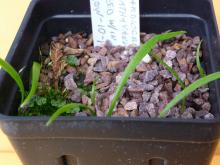
Colchicum hungaricum. Planted 15 March 2011, these went through two natural warm and two natural cold cycles to emerge 15 May 2013.
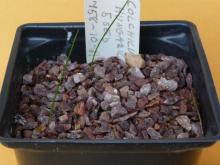
Crocus speciosus planted 5 Feb 2012, and again only a month of cold conditioning, emerged 8 May 13.
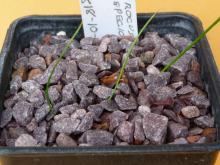
Mertensia ciliata (Thanks Lori!). Planted 3 Feb - outside temps, emerged 1 May.
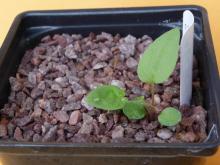
Silene hookeri planted 7 Feb at 60-65F, then in fridge 17 March, then outside 4 May. Emerged 15 May.
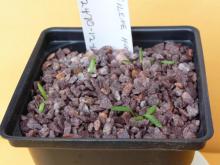
Mark McDonough
Re: Seed starting chronicles 2013
Sat, 05/25/2013 - 10:35pmI really like this topic, fascinating to see how people have sown their seed and see the results. I take the lazy man's approach, sowing seed out in the garden for some items, and for others (equally as lazy) sowing in flats and letting mother nature do the work over winter and spring. Here's some things germinating recently, the non-stop pouring rain for the entire last week certainly helps germination along, suddenly many Arisaema are showing.
I've had Carex appalachica for almost 10 years, one of the best species, with thread-fine foliage and tiny yellowish flowers that create a haze of tiny "points of light", I have yet to capture an adequate photo of it. No seedlings have ever appeared, so I sowed seed collected from my plants last summer, they're coming up. It's very slow growing (and expensive to buy), so I'm glad for the increase.
http://www.newenglandwild.org/images/plantcatalog/carex-appalachica-1.jp...
Iris lactea and an Arisaema sp., both collected in the Himalaya by Chris Chadwell. Pleased to get such good germination on the Iris. On Arisaema, I had about 5 species all show germination just this week, they are typically late-emerging seedlings.
Lindelofia stylosa Cc7161 (Chris Chadwell seed from the Himalaya), needs transplanting soon.
Iris cristata - seed from mixed named forms 2012, these were planted out yesterday (in the rain), about 30 seedlings.
Epimedium grandiflorum f. flavescens 'Nanum' - my seed 2012, all will be hybrids. Last year I was traveling to Dallas TX for my work, for a little over a week, and missed much of the Epimedium seed ripening. Even so, I have about a dozen and a half Epimedium varieties germinating.
Arisaema sikokianum, just starting to germinate, sown in a large plastic salad/lettuce container (I ran out of my preferred peat flats last autumn, resorted to re-using grocery containers such as this, and blue styrofoam mushroom "flats" seen in some of my other shots. My Arisaema seed were sown "whole berry" rather than being cleaned; each berry has 2-5 seeds in it. Many more seedling coming up since I took this photo last week.
Jeffersonia dubia (two flats front to back), and J. dubia "Korean Form" on the left (back), with 2nd year plants of Diphylleia grayi on the left.
Glaucidium palmatum white form, on the right, and one seedling so far of Clintonia andrewsiana on the left (hoping for more); thank you NARGS Forumists!
Botanica (not verified)
Re: Seed starting chronicles 2013
Mon, 05/27/2013 - 12:09pmVery impressed by your seeding result McDonough !!
I love the Arisaema sikokianum seeding !! I've this plant this year .
Where you find the seed of this plants ...It's your own produced ?
I hope i could present to you new germination this weekend !! I cross the fingers ;D
Bowden (not verified)
Re: Seed starting chronicles 2013
Mon, 05/27/2013 - 7:55pmHoy, I'm fascinated by the mistletoe. Would a piece of copper wire wrapped around the tree branch below the mistletoe seedling possibly keep the slugs away? Not twisted tight, just round a few times like a spring?
Trond Hoy
Re: Seed starting chronicles 2013
Tue, 05/28/2013 - 1:12amMaybe it could work. I didn't realize it was a problem till the damage was done though, but the last seedlings on 3 different trunks are inspected every evening now!
Mark McDonough
Re: Seed starting chronicles 2013
Sat, 06/01/2013 - 8:37pmArisaema sikokianum germination from my own seed. I'm always surprised just how late these germinate, and surprised by the young trifoliate seedlings always showing such serrate leaf edges when mature plants don't. The experiment here, was sowing full berries (2-5 seeds per berry) without cleaning, and I'm convinced it works just as well as sowing cleaned seed. I'm taking the easy way sowing whole fruits, it works.
Botanica (not verified)
Re: Seed starting chronicles 2013
Wed, 06/05/2013 - 11:24amOHHHOOO very nice !
I've my first germination this year but not Arisaema sikokianum, other Arisaema .
But i've 2 Arisaema sikokianum (adult) this year but i think no seeds available.
If you've some for me for the next germination...i was very happy to have ..remember me :D ;)
Who many year to flowering plant form this young Ariseama ?
Thanks for sharing picture!
Botanica (not verified)
Re: Seed starting chronicles 2013
Mon, 06/10/2013 - 1:07pmSome picture of my germination project on growing !! ;D ;D
What do you think about that ..look good !
Primula alpicola

Polemonium pauciflorum Sulphur Trumpets
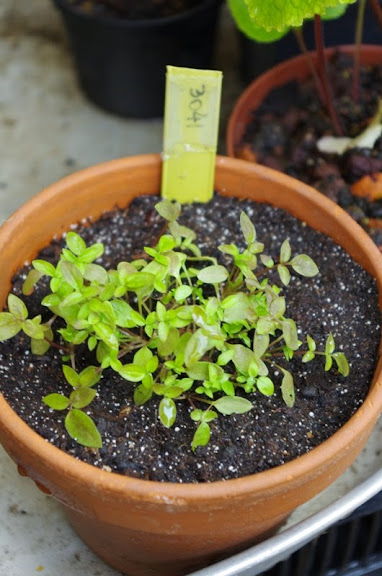
Some others
1

2
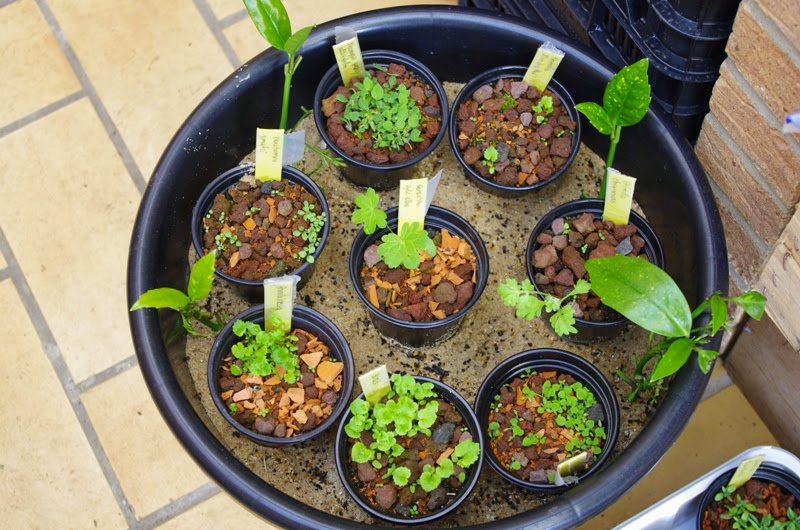
Iris setosa
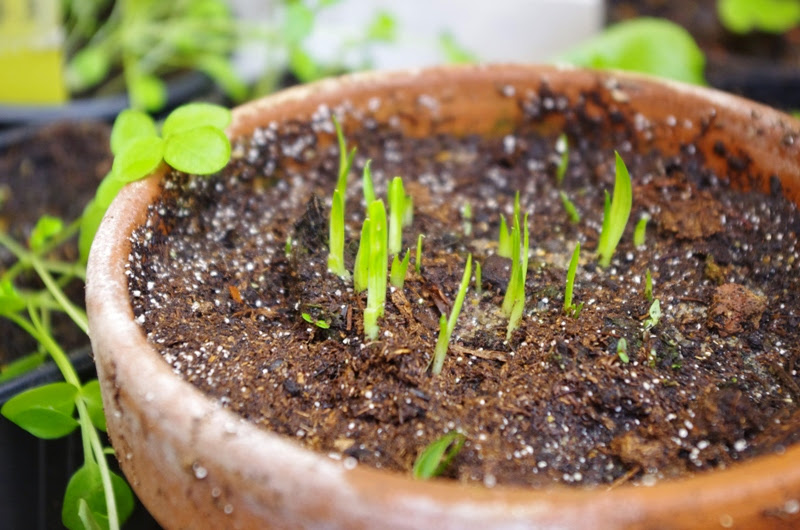
The nursery on batch
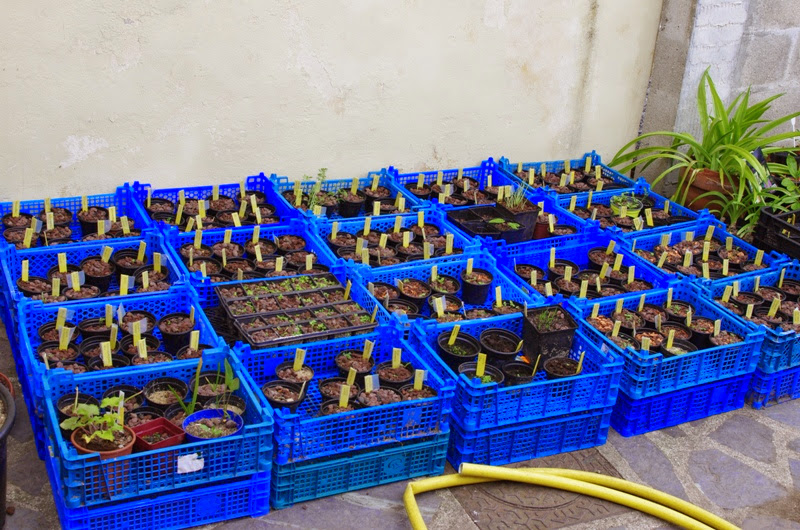
Toole (not verified)
Trillium seed.
Sat, 06/22/2013 - 3:58amTrillium seed.
I always enjoy this time of the year working inside the open weaved shade house tipping out some of the mix in every Trillium seed pot to see what’s happening under the surface.
Pots that have some ‘action’ in them are lifted from under the benches and placed higher so I can enjoy watching them at a closer distance.
Pic 1
Nearly all the ‘action’ pots have seed at what I call the ‘bent finger’ stage, where having formed a small rhizome upon germination over the last few months ,the cotyledon is now starting to push out and away from the near defunct seed, awaiting some warmth in early spring to appear above the surface.
Pics 2 and 3 .
However there are a couple of pots further advanced ,where the cotyledon is nearly in full growth.
Trillium rivale NZ Trillium Group Pic 4
Trillium sulcatum home seed Pic 5
Cheers Dave.
Richard T. Rodich
Clematis potaninii . First
Mon, 06/24/2013 - 9:18pmClematis potaninii . First seedling emerged in 29 days at 68F. Second in 52 days.
Clematis chisanensis did not sprout in 39 days of 68F. Put in fridge for for 48 days, than outside at similar temps to sprout with natural spring warming. Emerged in 38 days.
Castillea miniata (Thanks, Lori!). 38 days at 68F, than in fridge for a month, then outside at similar temps to sprout with natural spring warming. Emerged in 12 days.
Silene hookeri did not emerge in 35 days at 68F. Placed in fridge for 48 days, then outside in 55-75F temps. Emerged in 11 days.
Lilium humboltii planted at 55F emerged in about a month and a half. They were in a dark cellar type environment and unfortunately, I didn't catch them sprouting in a timely manner. Now I wish I had take a photo of them in their purely etiolated state. Very thick for etiolated petioles and there was no indication of of a lef blade at all. With light, the end sections either widened to produce leaves, or the ends grew more to produce the leaves.
Lilium parryi x unknown (second pic) planted at 55F in the same dark cellar conditions did not emerge after 3 months. When brought outside with temps around 65 and light, they emerged in 7 days.
The first Iris rosenbachiana (seed collected in Tajikistan) has emerged after 4 years in outdoor conditions. Woohoo!
(Taking over the pot is a Leibnitzia anandria volunteer.)
Some seedlings from the garden:
Corydalis cheilanthifolia, Angelica gigas, Helleborus purpurascens and Ruellia humilis.
Toole (not verified)
Interested in seeing your
Tue, 06/25/2013 - 2:30amInterested in seeing your Castilleja miniata seedlings Rick .
Many many years ago i placed 4 seeds around the base of a pot of Arthropodium candidum as I understood it needed a host .All the seeds germinated and i had a wonderful flowering pot for 4 or 5 years .
Unfortunately I've never been able to repeat the success with any seed I've come across since and I'm wondering what is the current experience of yourself and others regarding Castilleja being parasitic ?.
Cheers Dave.
Richard T. Rodich
TGhis is my first experience
Tue, 06/25/2013 - 11:51amThis is my first experience with any Castillea. I never expected all the seeds to germinate!
But I have a lot to play with now (as long as they continue to grow).
Longma (not verified)
A few Lilium sp. here ( names
Fri, 06/28/2013 - 2:34amA few Lilium sp. here ( names are revealed by placing cursor over the picture, or they are displayed at the bottom of the picture when enlarged ).
Sown over a year ago and kept moist for the first couple of months. When nothing developed I let them dry out entirely, convinced that the seed was not viable. A good soaking this year and the results are OK.
Richard T. Rodich
To get the names to show as
Fri, 06/28/2013 - 9:35amRon, to get the names to show as you want when you hover over the pic and when you click to view, you need to enter the name in the "Title" box, rather than the "Alternate text" box. But if you don't put the name in the text of the message, please also put it in the "Alternative text" box, too, so it can be searchable (when the search engine is fixed).
I changed it for you. You can see what I did by clicking the "edit" button at the bottom of your post.
Longma (not verified)
Understood. Thanks Rick.
Fri, 06/28/2013 - 9:39amUnderstood. Thanks Rick.
Richard T. Rodich
Forgot to comment on your
Fri, 06/28/2013 - 9:45amForgot to comment on your really good results.....
I've almost no luck with Lilium lophophorum seed, with only one coming up in the second year. And like Gene, I only get one to three mackliniae germinating per season. I would have thought drying out the seed after it imbibed water would mean sure death. Do you think the pots really got that dry?
Longma (not verified)
RickR wrote:
Fri, 06/28/2013 - 10:03am[quote=RickR]
I would have thought drying out the seed after it imbibed water would mean sure death. Do you thing the pots really got that dry?
[/quote]
To be honest, so did I Rick, but I was wrong. The pots were absolutely powder dry, under the greenhouse bench in light shade, not watered for 10 months. The same has happened for Lilium sempervivoideum sown at the same time as the others. Just showing some green through the surface today! These pots became absolutely soaked ( as much as the very gritty compost I use can be soaked ), almost by accident, and have continued very moist.
Thinking as I type, this is the exact same pattern I experience with seed of Fritillaria dagana, which shows in the second year, after a wet / dry / wet regime, although they show and grow earlier in the year.
Richard T. Rodich
That's really enlightening.
Sat, 06/29/2013 - 11:15pmThat's really enlightening.
Wonders never cease!
cohan (not verified)
A very pleasant surprise
Wed, 10/09/2013 - 1:03amA very pleasant surprise today: I received some Salix seed from Trond some days back, S myrsinites, S polaris and S glauca. From what I could find, S myrsinites was likely to be a no go, since one page mentioned viability of less than 24 hours. S polaris had a mention of viability after longer storage-at least I think that was polaris..lol (though no description of what kind of storage), so I had a bit more hope for those, and they had reported high germination at warm. S glauca is supposed to need cold stratification, so i presumed those should still be viable.I don't know exactly when Trond collected the seed, but it had to get mailed, arrive here, and then took me a few days to get to them- so best case scenario they must have been a week or two old.
I sowed them somewhere around midnight Oct 05/ early 06. All were sown in mostly pure coir with a bit of native black wetland soil mixed in the top.Seeds spread around on the surface and sprayed generously with water to make them contact the soil. No covering. S myrsinites and S polaris were left indoors at coolish room temperature, in a tray of water, S glauca was put outside (though I will probably do another pot and leave them indoors in a cool spot).
To my great surprise, when I checked them this evening, there was germination beginning on S myrsinites! So much for less than 24hrs viability! A little later, after I sprayed the pots again, I noticed the beginning of germination also on S polaris! By this time, the S myrsinites seedlings which had just been little white nubs were actually showing green- those babies are fast!
Now to see if I can actually keep these things alive indoors all winter...
I also sowed Lysichiton americanus at the same time- with conflicting suggestions online -cool? warm? outdoors? I put one pot outdoors, and have two indoors which I will probably put in different spots.. maybe cool and colder? any thoughts welcome..
Richard T. Rodich
That's very useful
Wed, 10/09/2013 - 3:49pmThat's very useful information, Cohan. I hope Trond can give some more insight to the true age of the seeds.
My only experience with willow seed is with my own seed of Salix repens. I may have had another variety of S. repens (and a male) or else maybe it could have crossed with one of the other species I have. At any rate, I planted the seed the same day the catkin dehisced. Seed sprouted quickly, too, 4-6 days, I think. But I didn't get them to continue for very long.
Good luck!
cohan (not verified)
They are still alive-
Mon, 10/14/2013 - 11:52pmThey are still alive- myrsinites came up in quite large numbes, S polaris much less so, but there are a few- enough for me if they actually survive till spring, still a long way to go....
Pages